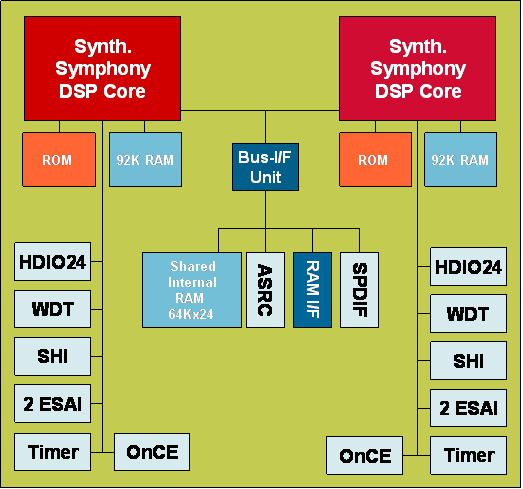On January 3rd, Freescale announced the first dual-core members of its Onyx family of audio DSPs. The first two chips in the family, the DSP56720 and DSP56721, feature two DSP5636x cores operating at 200 MHz. The chips mainly target high-definition audio processing in next-generation DVD players. To this end, Freescale offers DSP5636x software implementing audio decoders supported by the HD-DVD and Blue-Ray standards, including Dolby Digital+, Dolby TrueHD, and DTS-HD. In addition to DVD players, the chips will target other high-fidelity audio applications such as automotive infotainment equipment, recording consoles, and digital guitar amplifiers.
As shown in Figure 1, each DSP5636x “Symphony” DSP core has 92 Kbytes of local RAM and 192 Kbytes of shared RAM. To support the memory bandwidth and I/O requirements of high-def audio, Freescale has added 10 channels of DMA, a S/PDIF transceiver, and an SDRAM interface (previous Symphony DSPs supported only SRAM). Another new feature is a 10-channel asynchronous sample rate converter coprocessor, which supports mixing of audio signals with different sampling rates. This allows, for instance, mixing of CD and DVD audio without running sample rate conversion routines on the DSP cores.

Figure 1. Simplified Block Diagram of the DSP56720 architecture
The DSP5672x will face stiff competition for slots in next-generation DVD players. This competition will likely not come from other fixed-point DSPs, but rather from high-performance floating-point DSPs and SoCs. Analog Devices has struck early, announcing in July that its SHARC floating point DSPs are used for audio processing in the first commercially available HD-DVD players. Texas Instruments is also pushing a floating-point solution with its ‘C67x-based Aureus DSP. One major advantage of floating-point processors is quicker application software development for users implementing their own algorithms.
Freescale will also face competition from SoCs incorporating 32-bit general-purpose processor cores from vendors such as ARM and MIPS. Traditionally, general-purpose processors lacked the DSP horsepower for high-end audio applications, but newer architectures such as the ARM11 and the MIPS24KE not only have sufficient DSP horsepower, but may have enough free cycles to take on other tasks as well. MIPS has been particularly proactive in this area, partnering with Dolby to create a Dolby-certified, optimized implementation of Dolby Digital+ (Freescale’s Dolby Digital+ and Dolby TrueHD implementations are not yet Dolby certified). In the MIPS implementation, Dolby floating-point reference code was converted to fixed-point; then optimized assembly code was written for critical portions of the algorithm.
In high-volume products such as DVD players (there are now more first generation DVD players than VCRs), it will be hard to beat the cost/performance and energy efficiency of SoCs. The same day that Freescale announced the ‘5672x chips at the Consumer Electronics Show, Broadcom introduced the BCM7411D, an SoC capable of audio and video decoding of both HD-DVD and Blue-Ray formats. Also on the same day, LG Electronics unveiled the first multi-format DVD player, dubbed “Super Multi Blue.” A few days later, Broadcom revealed that LG has selected Broadcom’s SoC for use in its next generation players.
It is interesting that Freescale is continuing to use the DSP5636x processor architecture for its latest devices, considering the architecture’s age (the first DSP5636x chip was introduced in 1997). One major advantage gained by not changing architectures is that Freescale and its customers are able to reuse huge amounts of existing assembly language software implementing a variety of audio functions. The company reports that over 100 audio decoders and post-processing algorithms have been implemented on DSP563xx family DSPs. The extra precision provided by the 24-bit data path (compared to typical 16-bit DSPs) is also relatively efficient for high-fidelity audio algorithms. There are, however some significant disadvantages to this approach. One disadvantage is that, typically, it is difficult to achieve dramatically higher clock speeds with older DSP architectures. This is likely the reason why Freescale has adopted a dual-core approach, whereas most competitors use a single, faster core, which is likely to simplify application software development.
Freescale has announced that it is working on a new development tool suite, slated for release in the second quarter of 2007, that supports the DSP5672x family. But even with good tools, multi-core architectures are inherently more complex to program. In addition, older DSP architectures are typically poor compiler targets, meaning that much of the application software must be written in assembly language.
For DSP5672x users who will rely exclusively on Freescale’s off-the-shelf software, these programming considerations will obviously not be a factor. System developers implementing their own algorithms will have to weigh these considerations carefully, however.
In applications other than next-generation DVD players, the ‘5672x may be a good choice in situations where developers can replace multiple single-core DSP563xx DSPs with a DSP5672x and reuse existing DSP563xx code without much development effort.
According to Freescale, the DSP56720 and DSP56721 devices are currently sampling, with volume production scheduled for the third quarter of 2007. Freescale’s suggested resale price is $11.89 in 10k quantities.



Add new comment